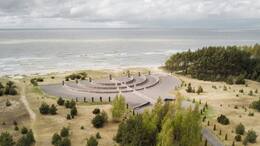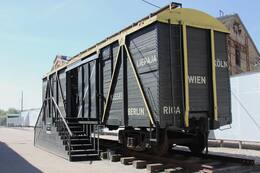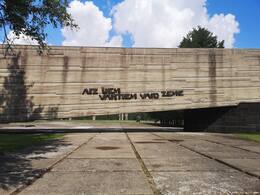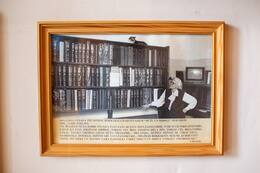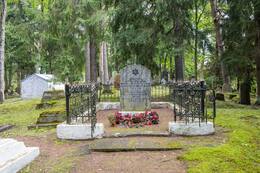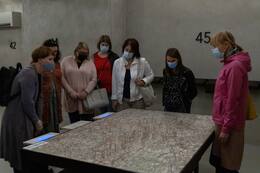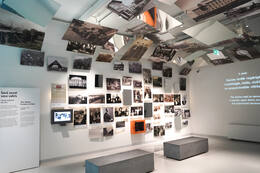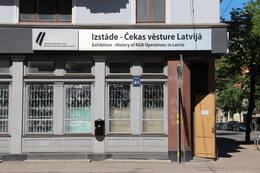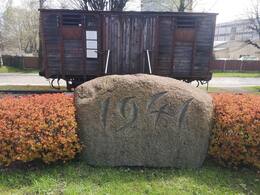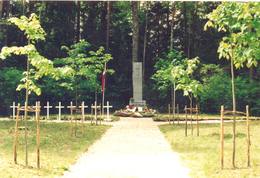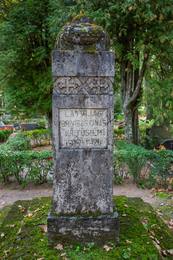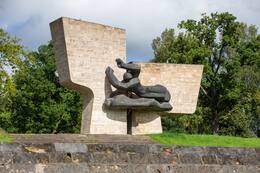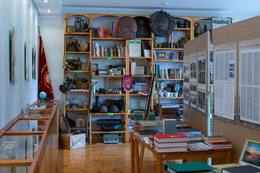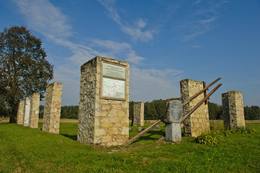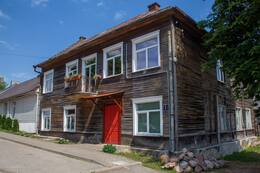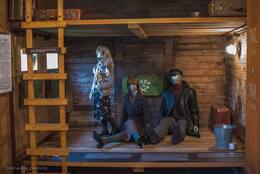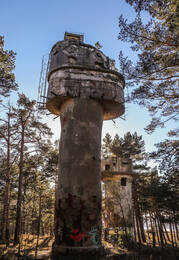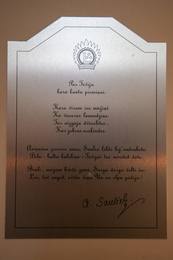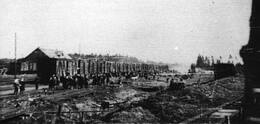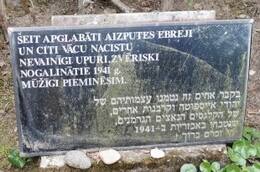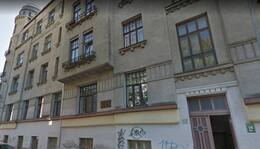Genotsiid II Maailmasõda, IV Nõukogude okupatsioon
Genotsiid (vana kreeka sõna "genos" - rass või hõim - ja ladina "tsiidi" - tapmine on rahvusliku, etnilise, rassilise või religioosse rühma kui sellise täieliku või osaline hävitamine: tapmise teel. selle rühma liikmeid, neid füüsiliselt sandistades või vaimselt traumeerides, luues sellisele rühmale teadlikult elutingimused, milles see tuleb täielikult või osaliselt hävitada, piirates tahtlikult selle rühma sündi, viies ühe rühma lapsed sunniviisiliselt ümber teine. Genotsiid hõlmab nii füüsilist aspekti – konkreetsete tegude, nagu teatud inimrühma tapmine – loetlemist, kui ka psühholoogilist aspekti: need teod pannakse toime konkreetse kavatsusega hävitada osaliselt või täielikult rahvuslik, etniline, rassiline või religioosne elanikkond. selline"..
Lisaks sätestab 1948. aasta konventsioon, et lisaks genotsiidile endale on kriminaalkorras karistatav ja karistatav vandenõu toimepanemiseks genotsiidiks, avalik ja avalik üleskutse genotsiidile ning genotsiidikatse või selles osalemine.
Lätlaste massiline hävitamine Nõukogude Liidus aastatel 1937-1938. Seda tuntakse ka kui genotsiidi või etnotsiidi, mis oli laiem osa poliitiliselt motiveeritud etnotsiidist mitme NSV Liidus elanud rahvusvähemuse vastu Suure Terrori ajal. NSVL Siseasjade Rahvakomissariaadi (NKVD) korraldusel arreteeriti üle 22 000 lätlase, "et likvideerida Läti luureteenistuse töö ja hävitada Läti natsionalistlik, nõukogudevastane tegevus NSV Liidus", neist 16 573 maha lastud ja salaja maetud Butovasse, Komunarkasse, Levašovi ühiskalmistule, Kuropatu metsa ja mujale. Maal likvideeriti 372 Läti kolooniat ja kolhoosi umbes 12 000 Läti taluga. Ohvrite täpne arv on teadmata, kuna kuritegu ei ole seaduslikult uuritud ja süüdlased pole kohtu ette antud.
17. juunil 1998 otsustas Läti Vabariigi Saeima tähistada Läti rahva vastu suunatud totalitaarse kommunistliku režiimi genotsiidi ohvrite mälestuspäeva detsembri esimesel pühapäeval. Lätis tähistatakse ka kahte kommunistliku genotsiidi ohvrite mälestuspäeva 25. märtsil ja 14. juunil, et mälestada 1949. aasta märtsi- ja 1941. aasta juuniküüditamise ohvreid. 4. juulil tähistatakse juudi rahva genotsiidi ohvrite mälestuspäeva.
Rohkem teabeallikaid
Genotsiid. Vikipeedia. https://en.wikipedia.org/wiki/Genoc%C4%ABds
Totalitaarsete okupatsioonirežiimide represseerimine Läti elanike vastu. 1940-1953 Läti riiklik ajaloomuuseum: http://lnvm.lv/?page_id=3976
Totalitaarsed okupatsioonirežiimid Lätis aastatel 1940-1964. Läti Ajaloolaste Komisjoni uurimus. Läti Ajaloolaste Komisjoni artiklid. 13. köide. Riia, 2004. https://www.president.lv/storage/kcfinder/files/item_1618_Vesturnieku_komisijas_raksti_13_sejums.pdf
Seotud ajajoon
Seotud objektid
Kommunistliku genotsiidi ohvrite memoriaal mälestuskivi
Memoriaal asub Pilistvere kalmistul.
Memoriaali rajamist alustati 1988. aastal talgukorras 300 inimesega. Vabatahtliku ühistööna on seda jätkatud ning memoriaal täieneb aasta-aastalt. Idee rajada selline memoriaal tuli vabadusvõitleja Lagle Parekilt.
Memoriaali keskmes on kividest kuhjatud kivikangur, kuhu on toodud kive kõikjalt Eestist, Siberist ja kaugemaltki paljude väliseestlaste poolt. Kivikangru peatsis on suur rist, mille jalamile sümboolsele hauale põllukive kokku kandes meenutab Eesti rahvas Siberisse küüditatud omakseid.
Kivikangrut ümbritsevad maakonna kivid, mis on kujundatud Aate Helina Õuna poolt ning püstitatud järk-järgult.
Veidi eemal asuvad eraldi mälestuskivid Tšornobõli radiatsiooniohvritele, metsavendadele, tööpataljonlastele, soomepoistele ja vabadusvõitlejatele. Kivid kujundas Endel Palmiste.
Lisaks kivikangrule on memoriaali juurde istutatud mälestuspuude hiis, kuhu on istutatud üle 2000 puu. Mälestushiie haljastusprojekti autor on tuntud maastikuarhitekt Andres Levald.
Pilistvere ajaloolises pastoraadis, mis on ühtlasi memoriaali peahoone, asub Eesti ajaloomuuseumi koostatud Eesti okupeerimise teemaline püsinäitus ja arhiiv.
Holokaustiohvrite memoriaalansambel Liepājas
Läti suurim holokaustiohvrite memoriaalansambel asub Liepājas Šķēde liivaluidetes. Memoriaalansambel on pühendatud rohkem kui 3000 Liepāja juudi mälestusele, kes tapeti Teise maailmasõja ajal. See on Iisraeli rahvussümboli menoraa ehk 7-harulise küünlajala kujuline. Memoriaali kontuur, mida on hästi näha linnulennult, on valmistatud lõhutud kivirahnudest ja graniitplokkidest. Menoraa tuled on valmistatud graniitsammastest, millele on raiutud heebrea, inglise, läti ja vene keeles värsid Jeremija nutulauludest.
Riia Geto- ja Läti Holokaustimuuseum
Riia Geto- ja Läti Holokaustimuuseum asub Riias keskturu ja pearaudteejaama läheduses. Muuseum avati 2010. aastal kohas, kus kunagi asusid linna laod. See on rajatud ajaloolisse linnaosasse, mis piirnes endise juudigetoga. Geto ala on ainulaadne, sest arhitektuuriliselt ei ole see pärast Teist maailmasõda muutunud. See on mälestuspaik juudi rahva tragöödiale. Natsi-Saksamaa poliitika Läti juudi elanikkonna suhtes seisnes 1939. aasta lõpuni selles, et Saksa diplomaadid ja poliitikud üritasid avaldada survet Läti valitsusele juudivastaste meetmete rakendamiseks ja nende vabaduse piiramiseks. Pärast baltisakslaste lahkumist 1939. aastal ei olnud Saksa saatkonnal enam nii head ülevaadet elanikkonna meelsuse ja Lätis toimuva kohta. Kui Punaarmee okupeeris Läti ja hakkas ühiskonnaga manipuleerima, toetas osa juudi elanikkonnast uut okupatsioonivõimu. Pärast seda, kui režiim pöördus terve ühiskonna vastu, langes toetus kiiresti. Ometi oli tekkinud sügav lõhe elanikkonnas, mida püüdis hiljem ära kasutada järgmine okupatsioonirežiim, Natsi-Saksamaa. See lootis, et kohalik elanikkond ahistab ja ründab juute, kuid seda ei juhtunud. Saksamaa töötas välja uue plaani, mis alguses nägi ette Riia geto loomist, aga hiljem hävitas selle elanikud.
Salaspilsi memoriaalansambel
Salaspilsi memoriaalansambel ja ajaloonäitus asub Salaspilsi piirkonnas, 1,2 km kaugusel Riia-Daugavpilsi maanteest A6. Salaspilsi memoriaal avati 1967. aastal kohas, kus Teise maailmasõja ajal asus Salaspilsi laager. See on müütidest ja pooltõdedest ümbritsetud koht, mida kasutati nõukogude propaganda jaoks, natside kuritegude ja kommunistliku ideoloogia näidis. Salaspilsis asus karistuslaager, mis oli osa Saksamaa karistusasutuste süsteemist. See sarnanes koonduslaagritega, kuid ei olnud üks neist. Laager loodi selleks, et Riia vanglates poleks liiga palju vange. Laager oli politseivangla laiendus. Siin hoiti vangis erinevaid inimesi, näiteks juute, Punaarmee sõjavange, tööle hilinejaid, poliitvange, kriminaalkurjategijaid, prostituute, Läti vastupanuliikumise liikmeid ja Saksa armees või politseis teeninud balti sõdureid. Laagris võis ühtaegu olla kuni 2200 vangi. Surma põhjustasid peamiselt (~2000) kehv toit, töötingimused, kehaline karistamine ja haigused.
Melānija Vanaga muuseum ja Siberi muldonnMelānija Vanaga muuseum ja Siberi muldonn
Kirjanikule ja kultuuriloolasele Melānija Vanagale pühendatud muuseum asub Amata külakoolis Võnnu (Cēsise) vallas. Muuseumis on välja pandud materjalid Vanaga elu, kirjandusliku tegevuse, suguvõsa ja saatuse kohta, seal on videomaterjalid Siberi ja sinna küüditatud lätlaste kohta ning Siberi muldonn, mis viib külastajad rännakule kirjaniku küüditamispaika Krasnojarski krais Tjuhteti rajoonis. Muldonni välimus ja sisseseade annavad realistliku ettekujutuse elust võõrsil. Muldonnis eksponeeritakse ainulaadseid ajaloolisi esemeid, mis on toodud Tjuhteti muuseumist: kasetohust nõu, savikruus ja petrooleumilamp. Muuseumis võib vaadata videointervjuusid piirkonna poliitiliselt represseeritud elanikega ja Melānija Vanaga raamatu „Veļupes krastā“ (Hingede jõe kaldal) kaheksateistkümne tegelasega. Muuseumi virtuaalne näitus „OLE SINA ISE!” (http://esipats.lv) avab viie küüditatud lapse ja nende vanemate kogemust, keda nõukogude võimud süüdistasid alusetult kodumaa reetmises.
Varaklani juudi kalmistu – mälestusmärk saksa-fašistliku terrori ohvritele
Varakļāni juudi kalmistu Kapsētas tänava lõpus.
Varakļāni juudi kalmistul on pärast sõda kaks mälestussammast püstitatud ellujäänud sugulaste ja sugulaste poolt.
Üks neist asub kalmistu piirdeaia lähedal, kus toimus juutide massiline hävitamine. Selle peal olev kiri vene ja jidiši keeles kõlab: "Me leiname igavesti koos oma vanemate, vendade ja õdedega, kes surid 1941. aastal fašistide käe läbi." Teine monument on surnuaia sees; Kohas, kuhu tapetud juudid hiljem ümber maeti, on ka jidiši- ja venekeelne kiri: "Igavene mälestus saksa-fašistliku terrori ohvritest – 4. augustil 1941 julmalt tapetud Varakļāni juutidest".
Natsi-Saksamaa väed sisenesid Varaklani 1941. aastal. Juuli alguses ja esimestest päevadest peale algas juutide piiramine ja üksikud tapmised. Juudi kalmistu lähedale rajati tinglik geto, kuhu kõik juudid pidid kolima. 4. augustil lasi Saksa SD üksus ("Arāja meeskond") kohalike omakaitsejõudude abiga juudi kalmistu territooriumil maha praktiliselt kõik Varakļāni juudid (umbes 540 inimest).
Iga aasta augusti esimesel pühapäeval toimub Varakļāni juudi kalmistul mälestusüritus, mis on pühendatud Varakļānis tapetud juutidele.
Valu mälestusmüür
Artrodas Litene kalmistu.
14. juunil 2001 avati Litene kalmistul arhitektide Dina Grūbe, Benita ja Dainis Bērziņši, kiviraidurite Ivars Feldbergsi ja Sandra Skribnovskise loodud mälestusmärk “Valu müür”, mis sümboliseerib 1941. aastal hukkunud sõdurite puhkepaika. 1988. aasta oktoobris leiti Litene vallas Sita Sililas endise Läti armee suvelaagri territooriumilt 1941. aasta juunis Nõukogude armee poolt tapetud 11 ohvitseri põrm. Kuigi neid ei suudetud tuvastada, maeti 2. detsembril 1989. aastal Gulbene Evangeelses Luterlikus kirikus toimunud pühitsemise jumalateenistusel Litene kalmistule pidulikult ümber.
11 valget risti, mälestustahvel ja infostendid.
Ajaloonäitus „Põlev südametunnistus”
Ajaloonäitust „Põlev südametunnistus” eksponeeritakse Võnnu (Cēsise) lossiplatsi lähedal. See asub nõukogudeaegses ajutises kinnipidamisasutuses ning tutvustab Läti okupatsiooniaega, tutvustab üllatavaid ja kangelaslikke lugusid sellest, kuidas inimesed režiimile vastupanu osutasid. Hoovi on rajatud mälestussein 643 Võnnu piirkonna elaniku nimega, kes hukkusid Nõukogude repressioonide tõttu, sh 1941. ja 1949. aastal küüditatud, mahalastud või surma mõistetud metsavennad. Näitus tutvustab Läti okupatsiooniaega aastatel 1939–1957. Temaatilised tsitaadid kohalikest ajalehtedest võimaldavad võrrelda kahe okupatsioonirežiimi poliitilist propagandat. Kuus ajutiseks kinnipidamiseks mõeldud kambrit on tänaseni säilinud sellisena, nagu need olid aastatel 1940–1941 ning sõjajärgsetel aastatel. Siin hoiti enne KGB Riia peahoonesse saatmist eeluurimise ja ülekuulamise ajal neid Võnnu piirkonna elanikke, kes olid kinni peetud nõukogudevastase tegevuse tõttu: metsavendi, nende toetajaid, noori, kes levitasid nõukogudevastase sisuga lendlehti ning teisi ”isamaareetureid”. Siin on kõik algupärane: raudustega kambrid, uste sisse ehitatud toiduluugid, puulavatsid, kinnipeetavate käimla, väike köök koos ahjuga, tavapärased nõukogudeaegsed õlivärviga kaetud seinad. 2019. aastal sai väljapanek Läti disaini aastaauhinna konkursil rahvusdisaini kategoorias kolmanda koha.
Läti Okupatsiooni-muuseum
Muuseumis eksponeeritakse Läti ajalugu Natsi-Saksamaa ja Nõukogude Liidu okupatsiooni ajal aastatel 1940–1991. „Tuleviku maja“ on okupatsioonimuuseumi rekonstrueerimis- ja laienemisprojekt, mille autor on Ameerikas elav tuntud läti arhitekt Gunārs Birkerts, ning sellega seotud uus muuseumiekspositsioon. Okupatsioonimuuseumi väljapanek „KGB ajalugu Lätis“ asub KGB-hoones (Nurgamajas). Läti Okupatsioonimuuseum asutati 1993. aastal. See jutustab pikka aega varjatud loo Läti riigi, rahva ja maa saatusest kahe võõrriigi totalitaarse okupatsioonivõimu all aastatel 1940–1991. 2020. aasta lõpus kuulus muuseumikogusse üle 70 000 ajaloolise eseme (dokumendid, fotod, kirjalikud, suulised ja materiaalsed tõendid, esemed ja mälestusesemed). Muuseumi spetsialistid on salvestanud rohkem kui 2400 videomälestust, mis teeb sellest ühe suurima okupatsiooni käsitleva kogu Euroopas. Lätis, Leedus ja Eestis toimunud sündmused näitavad meile selgelt, mida need rahvad pidid kahe totalitaarse režiimi all kogema.
Näitus KGB hoones „KGB ajalugu Lätis"
Külastajatele on avatud endine KGB ehk NSVLi riigi julgeoleku komitee hoone. KGB-lased vangistasid, kuulasid üle ja mõrvasid siin Läti kodanikke, keda okupatsioonirežiim pidas enda vastasteks. Hoonesse on välja pandud Läti Okupatsioonimuuseumi näitus KGB tegevuse kohta Lätis. Vangikambrites, koridorides, keldris ja sisehoovis korraldatakse ekskursioone. 1911. aastal ehitatud maja on üks Riia kaunemaid hooneid. Rahva seas kutsuti hoonet Nurgamajaks ja see oli Nõukogude okupatsioonirežiimi kõige hirmsam sümbol Lätis, üks NSVLi võimusambaid. KGB tegutses Nurgamajas 1940–1941 ja uuesti aastatel 1945–1991. Poliitiline tagakiusamine puudutas otseselt kümneid tuhandeid Läti elanikke. Võitlus Nõukogude vaenlaste vastu jätkus ka pärast Teist maailmasõda. KGB tegutsemisviis muutus veidi pärast Stalini surma. Füüsiline piinamine asendus psühholoogilise terroriga. Enamik KGB agentidest olid lätlased (52%). Venelased moodustasid suuruselt teise rühma (23,7%). 60,3% agentidest ei olnud kommunistliku partei liikmed. Kõrgharidus oli 26,9% agentidest. Süsteem oli üles ehitatud kohalike elanike kaasamisele, et seeläbi saavutada kontroll ühiskonna üle. Töötajate nimekirjad ja teenistusdokumendid asuvad Venemaal. Need ei ole Läti ametivõimudele ja teadlastele kättesaadavad.
Kommunistliku terrori ohvrite mälestuspaik Torņakalnsis
Mälestuspaik asub Torņakalnsi raudteejaamas Riias. See on pühendatud 1941. aasta juunis küüditatud Läti elanikele. Esialgu oli plaanis teha mälestuspaik Esplanāde parki, kuid hiljem otsustati see rajada Torņakalnsi jaama. Mälestuspaik koosneb viiest lõhutud kivist tehtud skulptuurist, mis sümboliseerivad hävitatud perekondi ja kolme küüditatute põlvkonda. Mälestuspaiga autorid on skulptor Pauls Jaunzems ja arhitekt Juris Poga. Selle avas 14. juunil 2001 Läti toonane president Vaira Vīķe-Freiberga. Jaamahoone kõrval asub kaubavagun ja mälestustahvel küüditatud Läti elanikele. Mälestuskivi kirjaga „1941“ on 1,2 m kõrgune töötlemata kivirahn. Mälestusmärgi autor on skulptor Ojārs Feldbergs.
Alūksne Garnisoni kalmistu
Asub Alūksne järve kaldal, Kapsēta poolsaarel, Suure kalmistu territooriumil.
Neid käivitasid ja hooldasid 7. Sigulda jalaväerügemendi sõdurid 1930. aastatel ning pühitsesid 11. novembril 1932. aastal. Pärast Läti taasiseseisvumist hoolitses Alūksne vennaskalmistukomitee osakonnajuhataja Uldis Veldre garnisoni kalmistu korrashoiu, Alūksnega seotud puhkepaikade väljaselgitamise ja mälestusmärkide paigaldamise eest garnisoni. Kalmistu.
Garnisoni kalmistule maeti Läti Vabariigi armee sõjaväelased, 4. juulil 1941 Alūksnes Jāņkalniņši lähedal ja 7. juulil 1941 Ziemera valda võitluses enamlaste vastu hukkunud sõdurid ja tsiviilisikud.
Enamikul maetutest on valged metalltahvlitega puidust ristid, millel on märgitud lahkunu nimi, auaste või amet, samuti sünni- ja surmaaeg.
19. detsembril 1990 avati Garnisoni kalmistul mälestusmärk Lāčplēsi sõjaväeordu kavaler Vilius Spandegile. Samuti püstitati standardsed mälestustahvlid LKOK-le, kes surid või tapeti kommunistlikes koonduslaagrites ja keda ei maetud Lätti. 11. novembril 1990 püstitati mälestusmärk kommunistlikus koonduslaagris hukkunud Voldemārs Zaķisele.
Vendade Karvase kalmistu
Asub Alūksne - Ape maantee pool Angerjamaja lähedal, Karvast lõunas, Rezaka poole keerates.
Monument avati 12. septembril 1937. aastal. Graniidist šablooni kujundas Oem Dambekalns Riias Riias arhitekt Vemera Vitandi poolt.
1975. aasta sügisel hävitasid kohalikud kommunistid monumendi. 30. märtsil 1989 otsustas Alūksne rajooninõukogu monumendi taastada ja 30. aprillil 1989 püstitas Riikliku Elektrotehnikatehase (VEF) tööline Jānis Jaunzems ajutise puidust mälestusmärgi Läti hauakivi kujul. . Seal oli kirjas: "Siin taastatakse Karvase vendade monument."
Sel ajal parandati ka kõrvalasuvat Vennaskalmistut.
1993. aastal algas tänu Alūksne vennaskalmistu toimkonna juhi Uldis Veldre initsiatiivile taas mälestuspaiga taastamine. Uue monumendi valmistasid Cēsise kiviraidurist vennad Aivars, Austris ja Auseklis Kerliņi.
Monument avati 11. juunil 1994. aastal.
Vendade kalmistule on maetud neli Valmiera jalaväerügemendi 5. kompanii sõdurit - Jēkabs Sukse, Pēteris Leitlands, Ernests Puķītis ja Gustavs Ozols, kes hukkusid 2. aprillil 1919 angerjamaja lahingutes. Valmiera rügemendi sõdur Roberts Grazer maeti Valmiera rügemendi viienda sõdurina 1930. aastate keskel ja jäi kadunuks 31. märtsil 1919 Uues mõisas. Esialgu maeti ta tundmatuna, kuid hiljem leiti nimi ja raiuti see ausambasse. Apekalnsi kalmistule maeti viies Angerjalahingus hukkunud sõdur Augusts Dzedons (Ziedons).
Komis Intas kommunistliku koonduslaagris hukkunud LKOK-s osaleja Jānis Goldemi (1891–1952) ausamba jalamile on püstitatud mälestustahvel.
Teine mälestustahvel, mis avati 23. augustil 1992, püstitati ühe puuristi juurde ja on pühendatud 7. Sigulda jalaväerügemendi kapralile Peter Jansonile, kelle mõrvasid pealetulnud kommunistid 7. juulil 1941. aastal.
Militaarpärandi mälestusmärgid Dīvaliņši kalmistul Valmieras
Asub Valmiera Dīvala (Jāņa) kalmistul Valmieras.
Allaži paekivisse skulptor Marta Lange valmistatud monument avati 26. septembril 1937. aastal.
Sammasmonumenti sulgeb kaldaltar, millel on tammepärg ja paekivist kiiver.
Maetakse ligikaudu 80 Läti Vabadussõjas hukkunud sõdurit, samuti vigastustesse ja haigustesse surnuid.
Läheduses on üks vähemtuntud Kārlis Zāle teoseid - monument “Katkised roosid”, mis on seotud vendade kalmistuansambli rajamisega.
Seal on ka kommunistliku terrori ohvrite mälestusmärk - kivi, millel kiri: "1941. aasta kommunistliku režiimi palgamõrvarid" ja valged ristid.
Memoriaalansambel Teises maailmasõjas langenud sõduritele
Valmiera memoriaalansambel avati 1985. aastal. Vennaskalmistule on ümber maetud Teises maailmasõjas Valmiera ümbruses langenud Nõukogude sõdurid ja natsiterrori ohvrid. Memoriaalansambli autorid on skulptorid Zigrīda Rapa ja Juris Rapa, arhitektid Ēvalds Fogelis, Jānis Lejnieks, Jānis Rutkis ja Andris Vītols ning projekteerija Ivars Veldrums. Memoriaalansambli kaunistamiseks on kasutatud Allažist pärit allikalupja. Peamine figuur kujutab lõhestatud pärnapuud, mis on ka Valmiera linna vapil. Ansambli mõlemal küljel on kaks skulptuuri, mis sümboliseerivad elu ja surma rütmi. Koiva (Gauja) poole suunatud figuurid moodustavad poolringi ning tähistavad piiri endise ja praeguse vahel. Linnapoolne üldkujund on põimitud võitlusliku kaare vormi. Linna poolt mööda silda tulev külastaja näeb sõdurikuju, kelle käte moodustatud diagonaal toetab surnud kaaslast. Matmispaigas asetsevad hauad ridades, et need, kes võitlesid lahingus õlg õla kõrval, saaksid lamada sama maakamara all. Memoriaalansambli alumisel terrassil asub eraldiseisev kompositsioon „Kuldne õunapuu”. Graniitplaat meenutab siia ümbermaetud juute. Mõned elemendid, näiteks pronksist õunad, mis olid paigutatud õunapuu alla, kadusid 1990. aastatel. Memoriaali juures saab QR-koodi abil kasutada audiogiidile läti, vene, inglise, eesti ja saksa keeles.
Vaidava kihelkonna koduloo uurimise püsiekspositsioon
Asub Vaidava Kultuuri- ja Käsitöökeskuses.
Seal on välja pandud ekspositsioon, mis on pühendatud 1949. aasta küüditamiste mälestusele, aga ka riialaste osalemisele 1991. aasta jaanuaribarrikaadidel Riias. Näitusel on näha ka tõendeid maailmasõdadest (peamiselt trükised).
Loodus- ja ajalooobjektid, mõisad, hariduslugu, kultuur, silmapaistvad isikud, kolhoosiaegsed materjalid, majapidamistarbed, rahatähed, ajalehed, ajakirjad Vaidava kihelkonna kohta.
Kommunistliku terrori ohvrite mälestusmärk represseeritutele Jaunrauna vallas
Asub Priekuli vallas "Baižēni".
"Baižēni" maja aida varemete asemele loodi represseeritute mälestuspaik, kus ööl vastu 25. märtsi 1949 hoiti 40 Jaunrauna valla elanikku, et asuda teele Lode raudteejaama ja Siber hommikul.
Represseeritute hulka kuulusid alla 1-aastased ja 87-aastased lapsed.
Mälestustahvlile on kirjas ka paguluses mahalastud või hukkunute nimed. Selle kõrval on mälestuskivid Lāčplēsi sõjaordu rüütlitele.
Näitus „Abrene ruumid”
Näitus „Abrene ruumid” on üles pandud Viļaka kesklinna lähedale. See hõlmab ajavahemikku 1920–1960, kui Viļaka kuulus Abrene piirkonna Jaunlatgale haldusüksusesse ja oli Viļaka piirkonna ja Abrene rajooni keskus. Näitus asub Viļaka kõige huvitavama ja mitmekülgsema ajalooga hoones.
Algselt asus see māja kunagisel Marienhauseni turuväljakul, hiljem asusid siin korterid, bürood ja mitmesugused kauplused; Teise maailmasõja ajal tegutsesid siin Läti Omakaitse staap, Gestapo ja KGB. Näitusel eksponeeritakse esemeid, mis on pärit metsavendade laagrist Stompaki soos ning mis on seotud metsavendlusega Latgales, samuti on välja pandud Vabadussõjaga seotud dokumente ja fotosid. Kui tellida giidiekskursioon, tutvustab väljapanekut omanik Dzintars Dvinskis.
Küüditamiseks kasutatud karjavagun - muuseum Skrunda raudteejaamas
1941. aasta juuniküüditamise ja 1949. aasta märtsiküüditamise mälestuseks on Skrunda raudteejaama juurde püstitatud mälestuskivi ja neljateljelisse vagunisse sisse seatud muuseum. See on esimene vagunimuuseum Lätis, kus on püsiekspositsioon: fotod, kirjad, memuaarid, dokumendid ja küüditatud inimeste valmistatud esemed. Skrunda jaam oli koht, kuhu välja saadetavad inimesed kokku koondati, ja üks kolmest piirkonnajaamast, kuhu toodi inimesi Skrunda ja Kuldīga ümbruskonnast. 1941. aastal küüditati siit Siberisse Krasnojarski kraisse hiljem taasiseseisvunud Läti Vabariigi esimeseks presidendiks saanud Guntis Ulmanise perekond.
Karosta, Liepāja sõjasadam (ekskursioon)
Karosta on Baltimaade suurim ajalooline sõjaväeala, mis hõlmab peaaegu kolmandiku kogu Liepāja territooriumist. Karosta on ainulaadne sõjaväe- ja kindlustushoonete kompleks Läänemere kaldal, mis on eriline Läti ja kogu maailma ajaloos ja arhitektuuris. Karostas asuvad sellised militaarpärandi objektid nagu Põhjamuul ja -fordid, redaan, Karosta vangla, Karosta veetorn, Püha Nikolai õigeusu merekatedraal ja Oskars Kalpaksi sild.
Esimese maailmasõja ja vabadussõja Cesvaine ohvrite mälestussammas Cesvaine luteri kirikus
Asub Cesvaine luteri kirikus ja kiriku territooriumil.
Kirikus on näha mälestuspaik Esimeses maailmasõjas ja Vabadussõjas langenud koguduseliikmetele.
Vabadussõjas langenud Cesvaine ja selle lähiümbruse elanike mälestuseks taastati ja pühitseti kirikus 2004. aastal mälestuspaik, mis on luules pühendatud kirjanik Augustus Saulietisele.
Kõik 34 vanale plaadile graveeritud perekonnanime on ka plaadile graveeritud. Puualtari valmistas kohalik meister Juris Neimanis.
Kirikuaias saab näha 25. märtsil 2003 avatud ja pühitsetud mälestusmärki kommunistliku genotsiidi ohvritele.
Cesvaine Evangeelse Luterliku Kiriku jaoks said II maailmasõjas kannatada torni katus ja vundamendid. Sõjajärgsetel aastatel hävisid orel, altar, kantsel ja aknaklaasi pliiraamid. 29. märtsil 1964 peeti kirikus viimane jumalateenistus, kuid 1978. aastal töötas arhitekt Maija Elizabete Mengele välja pärimusmajana kasutatava kiriku rekonstrueerimisprojekti. 1985. aastal moodustati meistrimeeste grupp siseruumide rekonstrueerimistööde tegemiseks. 25. augustil 1990 peeti osaliselt taastatud kirikus esimene jumalateenistus, mida juhatas peapiiskop Kārlis Gailītis (1936 - 1992). 1994. aastal lõpetati altari ja kantsli ehitus. 17. augustil 2002 pühitses peapiiskop Jānis Vanags osaliselt restaureeritud oreli.
Allikas: http://www.cesvaine.lv/turisms/apskates-objekti-cesvaines-novada/cesvaines-luteranu-baznica.html
Mälestuskivi Stende raudteejaamas
Ventspilsi-Mazirbe raudteeliin, samuti Stende-Dundaga pikendus Mazirbesse koos haruga Pitragsi, oli ette nähtud ainult strateegiliste sõjaliste vajaduste rahuldamiseks. Nende liinide ehitamise ajal ja pärast seda evakueeriti kõik tsiviilelanikud piirkonnast. Irbe väina piirkonnas asuvate sõjaliste raudteede peamine ülesanne oli Saksa armee rannikukaitsepositsioonide varustamine relvade ja laskemoonaga.
Need ainult sõjaväe kasutuses olevad sõjaväe raudteed ühendasid ka kolme kõige tähtsamat tuletorni, mis asusid Ovišis, Mikeltornis ja Šlīteres.
Sellest hoolimata korraldati juba I maailmasõja aastatel ka reisijatevedu.
Stende raudteejaamas asub mälestuskivi (1989) 1941. ja 1949. aastal küüditatud lätlastele.
30. oktoobril 1919 hõivasid Stende raudteejaama Bermonti väed. 17. novembril ründasid K. Šnēbergsi juhitud Läti sõjaväe sõdurid jaama, ajades ära vagunid relvade, sõjavarustuse ja viljaga. Nende lahingute eest pälvisid 6 sõdurit ordeni: K. Bumovskis (1891-1976), P. Strautiņš (1883-1969), R. Plotnieks (1891-1965), E. Jansons (1894-1977).
Holokausti ümbermatmispaik
Natsiväed sisenesid Aizputesse 1941. aastal. 28. juunil. Juba juuli alguses lasti Dzirkali metsas ja linnapargis maha osa juute, ülejäänud linna ja lähiümbruse juudid arreteeriti ja paigutati kahte linna sünagoogi.
Pärast seda toimus kahe aktsiooni käigus juutide massiline tapmine.
Tänaseks on ümbermatmispaika paigaldatud monument heebrea- ja lätikeelse kirjaga: "Siia on maetud Aizpute juudid ja teised Saksa natside süütud ohvrid, kes tapeti 1941. aastal julmalt. Me mäletame igavesti."
Tšeka ohvrite matmispaik Chumalu järve ääres
Cheka ohvrite matmispaik asub Lībagu vallas Chumalu järve lähedal Talsu - Laucienese maantee lähedal. Aastatel 1946-1947 lasti siin maha 14 inimest. On olemas versioon, et mahalastud hukkunute seas on metsavendade toetajaid.
Talsi prokuratuuril on selle juhtumi kohta info. Vaja on täiendavaid uuringuid.
Liepāja miilitsahoone ehk "Sinine ime"
Liepajas asus kommunistliku okupatsioonirežiimi institutsioon miilits Republikas tänav 19, majas, mis oli kasutusel alates selle ehitamisest 20. sajandil. alguses nimetasid Liepāja inimesed seda "Siniseks imeks". Seevastu tšeki peakorter asus aadressil Toma tänav 19. Varsti pärast okupatsiooni omandas see ühiskonnas nime "Punane ime".
Senise kommunistliku režiimi kuritegude uurimise käigus on tuvastatud, et ei otse Liepaja Cheka majas ehk "Punases imes" ega ka vanglas ei ole toimunud hukkamisi ega kohtuväliseid tulistamisi. Kõik nendes kohtades viibinud kinnipeetavad viidi alates 23. juunist 1941. aastal seoses sõja algusega Läti territooriumil üle Venemaa vanglatesse. See puudutas nii kinnipeetavaid, kes vahistati nn "poliitiliste" kuritegude eest, kui ka kriminaalkurjategijaid, sõltumata sellest, kas isik oli uurimise all või oli juba karistuse saanud.
Vangide üleviimine määrati NSVL Riikliku Julgeoleku Rahvakomissari Vsevolod Merkulovi 23. juuni 1941 korraldusega nr 2455/M, mis oli adresseeritud Läti NSV, Eesti NSV NKGB ja mitmete NKGB ülematele. Ukraina NSV piirkonnad. Tulistamise põhjus oli kohutav ja traagiline – kinnipeetavaid polnud enam võimalik Venemaale toimetada, kuid ellu neid jätta ei saanud. Seetõttu toimusid sõja ajal Liepājas elanike kohtuvälised mahalaskmised, sarnaselt Riia keskvanglas, Valmiera vanglas, Valka ja Rēzekne miilitsas ning Ludza lähedal Greizai Kalanis. Nimetatud kuritegu leidis aset "Sinise ime" - Liepāja miilitsamajas, Republikas tänav 19.
Seotud lood
Jean Lipki mälestused
Nõukogude okupatsioonile järgnes Saksa okupatsioon. Natsid sooritasid kuritegusid Läti rahva vastu. Üheks selliseks etniliseks rühmaks olid juudid. Esialgu asutati getod, kuid siis järgnes juutide hävitamine. Paljud lätlased päästsid juute hävitamisest. Üks neist on Jean Lipke.
1949. aastal Skrunda jaamas salaja pildistatud küüditamise ešelon
25. märtsil 1949 nägi Skrunda õpilane Elmārs Heniņš, kuidas tema klassikaaslased ära viidi. Ta võttis oma fotoaparaadi ja ronis lähedalasuval mäel asuvale männipuudele, et dokumenteerida toimuvat, hiljem aga peitis pildid.
Taaveti täht Dundaghi koonduslaagri mälestusmärgil
Pärast taasiseseisvumist paigaldasid Dundaga elanikud juutide mõrva- ja ümbermatmispaika Mazirbe - Dundaga maantee äärde suure puust Taaveti tähe ning hiljem avas Läti Juudi Koguduste ja Koguduste Nõukogu selle kõrval mälestuskivi. seda.
Major Jānis Ozoli juhtimisvõimed 3. Kurzeme lahingu ajal
Major Jānis Ozolase divisjonile on paigaldatud mälestussilt Riia - Liepāja maantee äärde, Džukste valda, umbes ühe kilomeetri kaugusel mälestuspaiga Kurzeme tagaveest.
Major Jānis Ozols oli Läti ohvitser, 2. maailmasõjas osaleja, Kolme Tähe ordeni kavaler, kelle juhitud suurtükiväedivisjon hoidis 3. Kurzeme lahingu ajal ära rinde murdumise.
23. veebruaril 1946 toimunud lahing Zūru meža Dzelzkalni ümbruses
1945/46. Misiņa rühm veetis 2010. aasta talve Zūru metsas Dzelzkalni piirkonnas, kuhu oli ehitatud mitu punkrit. Siia jäi umbes 40 partisani. 23. veebruaril 1946 piirati laager NSV Liidu sisevägede poolt ümber ja toimus äge lahing.
Liepāja "Sinises imes" tsiviilisikute kohtuväline tulistamine
Sõja ajal Läti territooriumil toimunud kohtuvälised tapmised 1941. aasta juuni lõpus ja juuli alguses olid viimane repressioonide ja vägivalla ilming kommunistliku okupatsiooni esimeses etapis, mis lõppes Natsi-Saksamaa vägede sisenemisega kogu territooriumile. Lätist.
Tulistamise põhjus oli kohutav ja traagiline – kinnipeetavaid polnud enam võimalik Venemaale toimetada, kuid ellu neid jätta ei saanud. Seetõttu toimusid sõja ajal Liepājas elanike kohtuvälised mahalaskmised sarnaselt Riia keskvanglas, Valmiera vanglas, Valka ja Rēzekne miilitsates ning Ludza lähedal Croix’ mäel. Liepajas realiseeriti see Nõukogude okupatsioonivõimu kuritegu "Sinises imes" – Liepaja miilitsamajas, Republikas tänav 19.







